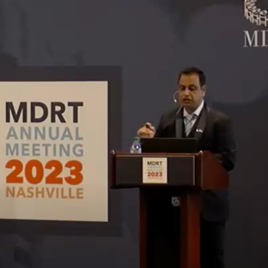Nov 24 2022
How to keep your clients engaged by observing what is not being said
Topics Covered
When servicing clients, it is important to keep them engaged and interested in what we have to say. Ketan Jhaveri, a 12-year MDRT member from India, believes in taking the approach of being a listener. He takes care to listen, more than speak when with a client, and ensures not to interrupt them or appear uninterested. He makes sure the client is at ease and there is no confrontation.
“There are multiple ways of offering explanations on topics where the client does not agree. I never argue with the client. Once I understand the client’s need, a solution can be suggested accordingly,” he says.
Jhaveri also adds that a critical approach serves no one. Therefore, he refrains from criticizing other clients or financial advisors.
He also believes in making a good first impression. He mentions that if a referral meeting has been set up, reconfirmation and punctuality should be a basic standard practice for financial advisors. Eye contact during the meeting and sitting directly across from the client also go a long way in establishing trust.
In one instance, it helped when he did his homework to strike up a conversation about the client’s hobby, cricket — the national pastime. Apart from regular meetings to keep abreast of the client’s needs, quick responses on tailored insurance plans were also key to securing that client. He also took the opportunity to remind the client that these activities were to safeguard his family.
Cues to analyze body language
To keep a client or prospect engaged, financial advisors also need to pay attention to non-verbal communication cues. Vishnu Priya Jena, a two-year MDRT member from India, believes that body language is an important tool to gauge the interest that the client has in the product being offered to them.
It is advisable to be sensitized to non-verbal shifts in the mannerisms of the client. Understanding these shifts in facial expressions, posture, voice and tone, among other factors, can go a long way. “This can help us steer the conversation with the client and gauge whether the solutions provided work for them,” she says.
Jena believes it becomes more important in the current scenario, since a fair share of the business is conducted on the phone. For example, while explaining gaps in the existing portfolio of the client, she prefers to break the plans into sections, such as education, wealth creation, income/term protection and retirement. She waits for the client to take the lead on which section interests them, and then provides the customized solution.
Jhaveri also believes that understanding the client’s body language is paramount. “If we don’t understand the body language, we can’t make out what he’s thinking. For the exercise to not be a waste of time for us and the client, it is critical we pay attention to the body language of the client,” he says.
Jhaveri maintains that the client should be closely monitored at every meeting to gauge an appropriate response to all their queries. He says that minute observations also matter. If the client has multiple questions about the proposal, he knows that the client is interested.
Conversely, if the client is busy with phone calls, where the priority is not being given to the conversation, he understands that he needs to diversify in the options he’s providing. “The client gives us cues, if he’s yawning or scratching his head, I know that he’s uninterested and I need to change track for a positive response,” he adds. He believes diverting the conversation to topics of the client’s interest momentarily can pique his interest. Jhaveri maintains that sports are a common icebreaker at such times. Weaving in from this diversion to shift the focus back to the client’s family and their dreams is a method that he commonly employs to recapture a client’s interest in the solution Jhaveri is providing, aligning to the client’s aspirations.
Enhancing the client experience
Having said that, the bedrock for improving the client experience will always be the age-old art of patient listening by financial advisors.
While Jena believes direct feedback from the client helps in bridging existing service gaps, Jhaveri emphasizes the need for a physical presence and that regular reminders and social visits on occasions and festivals are helpful to maintain client relationship. Information about new plans and products also keeps him on the client’s radar. His clients also appreciated gifts such as diaries and calendars.
Contact: MDRTeditorial@teamlewis.com




